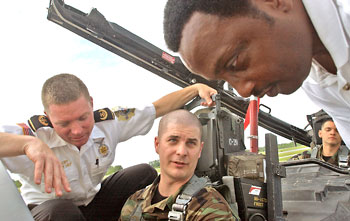Firefighters learn how to handle F-15 crash
By Kenneth Fine
Published in News on May 12, 2006 1:51 PM
KINSTON -- Imagine an F-15E Strike Eagle is forced to make an emergency landing outside county lines -- or worse yet, one loses control and crashes. Who would take care of the safety of the surrounding community, crew and jet?
Five members of the Seymour Johnson Air Force Base Fire and Emergency Service addressed those questions at Kinston Regional Jetpark Thursday as part of a training exercise for Kinston emergency responders.

News-Argus/Mitch Loeber
Assistant Chief for Training Sean Quimby, left, and Staff Sgt. Travis Buck, center, instruct firefighter Jim Wiggins, far right, on the proper procedures for evacuating a pilot from the cockpit of an F-15E. Seymour Johnson Air Force Base personnel trained a group of Kinston firefighters and state Highway Patrol troopers on what to do if an F-15E should crash at the Kinston Jetport, where they often make landings.
As Seymour's Assistant Fire Chief Sean Quinby gave a presentation to firefighters, law enforcement officers and airport personnel, he noted that jets from the base use Kinston's runway often. For that reason, first responders need to know how to handle a potential emergency involving the F-15E.
Quinby added the "class" was also an opportunity to learn basic information about the F-15E, to identify danger zones on the aircraft and to get a close look at one of the jets.
"Putting your hands on the aircraft will drive some of these points home," he said.
Quinby said there are many hazards associated with a downed F-15E -- presence of composite materials on the jet, large fuel tanks that can catch fire and explosive devices on the ejection seat.
But the most important facts to remember -- and avoid -- are the jet's "danger zones."
"If you have to approach the aircraft, the safest zone is to the pilot's left at 45 degrees," he said. "But there's almost not a safe place on this aircraft for us emergency responders."
As an example, Quinby said if a downed jet's engines are still on when responders arrive, the jet intakes are a danger zone. And then there's the radar, tail hook, exhaust in the back and, of course, the ammunition bay to avoid.
Still, he added, all of this can be avoided if the crew has already ejected and there is no threat to the community.
"If it crashes in the middle of a forest, look for the crew or parachutes," he said. "If they're clear, there's nothing there worth risking your safety over. It's just a plane. They can make more."
But should a crash occur in a populated area, the situation gets more serious and emergency responders might have to act.
"If it crashes into a building, that's going to be different," Quinby said. "You've got to protect your people and your community. Saving lives, that's what we're after."
After the presentation, the group spent the last 30 minutes of the event on the runway alongside an F-15E. Here, Kinston emergency staff got the chance to see and feel the Strike Eagle. Quinby pointed out more danger zones, including sharp edges on different parts of the jet and the ammunition bay.
"We want you to get an idea of the size and scope of the aircraft and the cockpit," he said. "Just remember, these eagles do bite."
